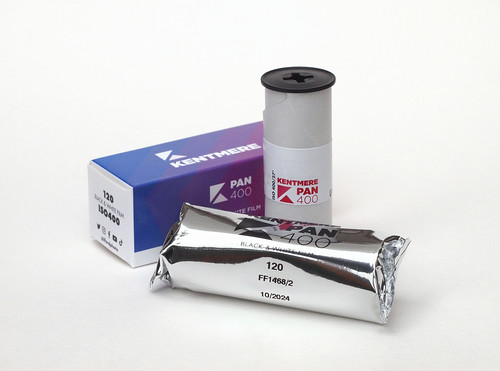 |
Kentmere Pan 400 in medium format
|
When I wrote my original post on Kentmere Pan 400 in 2019, it was then available in 35mm only; in December 2022, in a surprise announcement from Harman, the film's manufacturer, that the two black and white Kentmere emulsions were now to be available in medium format, having previously been available in 35mm only. I did write in my original post three years ago that "having been around for many years [Kentmere Pan 400] is unlikely to suddenly be offered in medium and large format, although this is not impossible: Ilford's Ortho Plus film, a niche sheet film emulsion for decades, has just been introduced in 35mm and 120." As described in the recent post on its slower-speed companion, Kentmere Pan 100, there's a logic to Harman complementing their Ilford brand with lower-priced films in medium format, to compete–in particular, it seems–with cheaper films such as Fomapan 100 and 400. The original post on Kentmere Pan 400 was written to compare the film with Ilford Pan 400, which I had been told was going to be discontinued (although at the time of writing, this film is still available), and one can see the logic in rationalising Harman's budget film lines.
After the announcement of the film's new availability in medium format, I bought a couple of rolls and used the film, cut down, for last week's 127 Day (I used the 16mm off-cut in a subminiature camera, but this suffered from successive overlapping exposures due to issues with the film advance, and so not worth illustrating here); I shot the other roll on New Year's Day, with the Ica Icarette II/L. The reason for choosing this particular medium format camera was simply not having used it for a while. As with the comments in the last post on 127 Day, with overcast winter weather, a one-stop push might have improved the contrast of the negatives; the Icarette's Tessar lens–99 years old–is uncoated, and the somewhat hazy conditions were no doubt emphasised in the results thanks to the low-contrast of the uncoated lens.
 |
| Ica Icarette II with Kentmere Pan 400 |
The image above, directed towards the sun, just about discernible on the day through the clouds, shows this quite well (thanks to the weather conditions, there may also–just–have been some haze as a remainder of the fireworks a few hours before). In the
original post on Kentmere Pan 400, I did test both pushing and pulling the film, and used Rodinal (or a Rodinal clone) and Ilfotec LC29 for developers, and in particular, having used Rodinal for many years, I was familiar with it and what to expect; with the medium format Kentmere Pan 400, I used Kodak HC-110 (at dilution B here), a developer new to me: with one or two rolls of film and a new developer, there wasn't the opportunity to work out how exactly to tailor the developer to exposure to get the particular result I wanted–or to use a different camera, which might have produced better results for these couple of rolls of Kentmere Pan 400 in medium format (as with the roll shot on 127 Day, the low contrast of the negatives was notable). As with my summary in the original post from just over three years ago, I feel there's nothing really distinctive about Kentmere Pan 400: I ended by writing then that the film is "a perfectly good, competitively priced, all-round 35mm black and white film with a certain flexibility in exposure and development"–which it is, but also now very welcome in medium format too.
 |
| Ica Icarette II with Kentmere Pan 400 |
 |
| Ica Icarette II with Kentmere Pan 400 |
 |
| Ica Icarette II with Kentmere Pan 400 |
 |
| Ica Icarette II with Kentmere Pan 400 |












